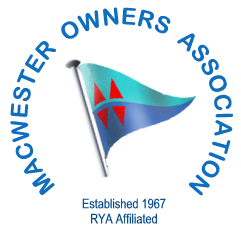A brief history
Below you will find brief extracts from two articles outlining the history of the Macwester Marine Company Limited, who were responsible for the design and production of the Macwester range of yachts.
Click the following link for more information on the Macwester Range: List of the yacht/boat types.
Macwester Marine was founded in 1964 by C.S.J.Roy to build and retail family cruising yachts.
The Macwester 26, the first production was shown at the 1965 Boat Show in London, and became an immediate success. In order to manufacture these yachts a former Fleet Air Arm hangar was leased on Ford Aerodrome in Sussex, and production commenced in February 1965.
The firm moved to River Road, Littlehampton, in 1968 and then expanded by taking on new manufacturing buildings on the Littlehampton Marina site in 1974. During this period Macwester built more than 1200 yachts of all sizes and all to Mr Roy’s designs.
In the early 1970s the company was manufacturing more than 100 yachts each year at the River Road yard and in 1977-1978 it exported more than half a million pounds worth of yachts to Europe and the USA. The company was one of the few in the UK who could undertake every operation of producing a glass fibre yacht design, mould making, and production. Between 1970-1980 the range had been consolidated to four main types, the 22’ Rowan, the Macwester 27, the 30’+ Wight/Malin class and finally the 36’Seaforth. The Rowan 22 became the Rowan Crown in 1978. Other classes were built in smaller numbers; the 15’ Kelpie, 26’6” Rowan Rose and 8 metre, and the 33’ Pelagian, a fast motor sailor under power, but a good sailing yacht under sail. During this period the mould for the Macwester 28 was also sold to Atlanta Marine, who used it as the basis for their Atlanta 28, 8.5m and Viking classes.
The manufacture of the then current range of Macwester yachts and the rights were purchased by Trident Marine Company Ltd. in 1979 who concentrated on building the Macwester 27, Rowan Crown, Malin and Seaforth.
Many Macwester yachts built in the very early days are still sailing in various parts of the World.
What’s in a Name – Macwester
Why Macwester? How did the name for this family of cruising yachts come about? It appears that Mr and Mrs Roy had a cottage at Yarmouth on the Isle of Wight and at the time owned an open launch which was essential for their regular journeys to Lymington. This launch was so wet to travel in that Mrs. Roy once was heard to say, “If I am going to that boat again, I shall have to wear a mac and a sou’wester”. She then put these words together, Macwester, and said that would be a good name for a boat. The name was never used for a boat but eventually passed to the Roys’ firm and the boats that were produced by it. (Mr. Roy will admit, with only a slightly embarrassed grin, that the launch in question was to his own design).
The Man Behind Macwesters – Mr. C.S.J. (Jim) ROY
The basis of the following article was originally written by Peter Gould in 1976 and gives a brief profile of Jim Roy the founder of Macwester Marine and designer of the Macwester range of yachts. At that time Mr Roy was Managing Director, Mr John Tweedie–Smith having bought a major interest in the firm. Jim retired in 1978 with 1185 yachts built to his Macwester designs. The yachts continued to be built by Macwester Marine and then Atlanta and Trident Marine of Fareham, until 1985. Jim, now in his 90s, lives near Poole and still maintains his interest in boats and Macwesters in particular.
Just about every letter we get concerning building or altering a Macwester bears testimony to Mr Roy’s interest, help and kindness. No one who has attended an AGM or Open Day can feel that they do not know him personally, because although basically a shy man, his short speeches captivate us, and he always manages a few words with the many guests on these occasions.
It will be no surprise to anyone that his major interest is boats but when he told me that he has few other interests I imagine that he really meant he is interested in everything and everybody that can be related to boats. He has owned a great many and varying boats ranging from an 1887 steam launch to dinghies (of which he reckons to have had dozens) and once, just before the outbreak of World War 2, he nearly became the owner of a 70 ton steam yacht. It was in 1922 that he first built a boat while at Preparatory School; she was a plywood rowing dinghy with a sail stuck on. That she was given no name but that Mr. Roy survived suggests that he is a practical experimenter rather than a romantic.
This practical trait led him to study Mechanical Engineering at London University during which time vacation employment with The River Lee Conservancy fostered his interest in small craft. However, like many others, the War had a profound effect on his career and having learned to fly while at University he soon found himself in Bomber Command. Eventually, a crash resulted in him being invalided out of the R.A.F. but this was not the end of the War for him; his ‘civilian posting’ was to Tough Brothers of Teddington where he started work as a shipwright.
He knew by now that he wanted to be involved with building small craft and was determined to adapt circumstances to learn all he could about every aspect of design and construction. At the same time, he had plenty of opportunity to learn about handling boats as he was already signed up in the Ferrying Service that provided crews to deliver and collect small craft of all sorts around the coast. Coinciding with and following this was a period of moving around shipyards in gradually more responsible jobs that ensured that he had experience of every type of major shipbuilding and repair job. But, at the same time he was always a yachtsman – at that time he had a 22ft sloop.
At the time of the 1951 depression in boat building, he was planning to get married and, sensibly, looked around for “a job with prospects”. With foresight and a desire to capitalise on his past academic and practical experience, he moved into the plastics industry and although he remained until 1962 in a firm concerned mainly with resin production, he maintained links with boat building.
It was in 1964 that Mr. Roy and his wife founded Macwester Marine. Apart from the impersonal reference in the previous paragraph, Mrs. Roy has not featured in this profile, but talking to him, one senses her presence and help all the time, contributing to the successes, providing support at difficult times.
Talking about himself and boats Mr. Roy constantly relates present to past, design to operation, boat production to social change and one is aware of a lively mind constantly drawing on a variety of ideas to maintain the forward impetus of his enthusiasm for not only boats but the whole of life involving them. For instance, reflecting on the days when Chichester Harbour was deserted, he recalls how a dinghy racing fleet circled round a capsized comrade to mark position until Mr. Roy, in one of his launches, could arrive to effect a rescue. In those days there were no buoyancy aids, no rescue boats and few people about. Only briefly regretting today’s crowded moorings, he adds that just after the War he was already drawing up plans top develop a non-tidal yacht basin at Chichester. The practical experimenter was again taking over from the romantic who might be lurking in the background.
This eclectic philosophy is also behind another aspect of his personal life, which gives him a certain amount of pride. He was, and still is, tremendously interested in the training of youth. Although apprenticeship schemes are fairly common in industry Mr Roy always started them up in places where he has worked, often against opposition. One of the features of Macwester Marine was that they encouraged the entry of apprentices attempting to give them first-class grounding in the industry. ‘In fact some of them did very well indeed after leaving the firm’.
© 2014 Macwester Owners Association | The Macwester Owners Association retains all the rights to the lists of members and/or their boats. The lists may not be copied in whole, or in part, reproduced, sold or used in any manner without the prior consent of the association in writing. Every attempt is made to ensure that the information contained in our databases is as accurate as possible. We apologise in advance for any inaccuracies.


